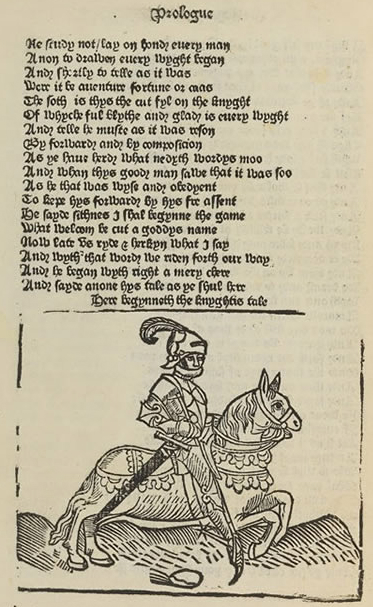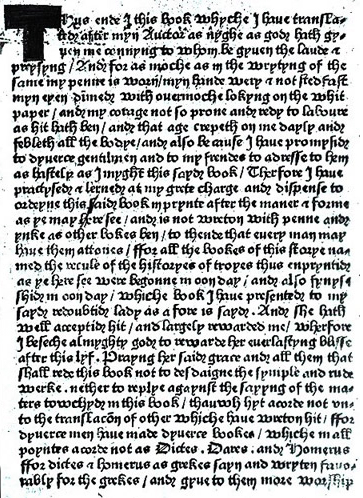
Reserved Area
Artists - ArtWorks
William Caxton
 United Kingdom
United KingdomAfter the printing press was brought to Britain, Caxton translated and printed the first book in the English Language
William Caxton was born 1422 in Kent. At age 16 he became an apprentice to Robert Large, a merchant. When Large died (1441) Caxton went to Bruges in Belgium and ran a successful textile business.
In 1468 he was employed by the King’s sister to translate books for her and subsequently was sent to Cologne in Germany to learn how to print. He learned about printing techniques from Johann Guttenberg.
In about 1474 Caxton returned to England and printed the first book in English ‘The History of Troy’ and, at about the same time, ‘The Game and the Play of Chess’ was the first book to contain woodcuts by Caxton as illustrations.
100 books later, he died aged 69 in 1491.
For much of Caxton’s life, England was in the throes of the War of the Roses which was between two of the largest families in the country, the Lancastrians and the Yorkists. This led to the destruction of considerable amounts of art held within religious buildings. Smaller, portable art objects like books, however, were better investments.
In 1440 the first mass production printing press was perfected in Germany by Guttenberg.
In 1470 Johann Heynlin set up a printing press in Paris. By the end of the century there were many printing presses at work all over Europe. Caxton set up his own press in 1476 in Westminster.
Manuscripts and simple woodcuts in the middle ages were mostly used for ecclesiastical purposes. By Caxton’s times English texts had moved away from being merely religious.
In the 15th century, woodcuts and prints usually involved a different craftsman at each stage of development, but not for Caxton. He completed each stage of the complex craft form alone.
When Caxton left the Low Countries to set up his printing press in Westminster he took with him sets of type. One of these was based on the rich Burgundian script, and was the type used for the first edition of the Canterbury Tales. This style of type is called littera bastarda which emulated the handwritten style earlier manuscripts (See Matthew Paris or the Luttrell Psalter). In 1480 he acquired a smaller version of the same design, which was used for the second edition of Canterbury Tales. Because it is smaller it is more economical; much more text fitted onto each page and less paper was needed.
Later, Caxton was noted for this Black Letter Type which imitated the more austere writing of the Haarlem Monks. He was considered to be the finest printer of his day because he revolutionised printing by developing the plainer type face.
The very first printing was developed in China in the 11th century.
Paper was brought to Italy from China in the 12th century but thought too flimsy for books. Prior to the printing press developments – books were made from vellum made from animal hide.
Guttenberg in Germany developed a printing method which used movable type (1452) and included the invention of metal moulds, alloys and oil based inks. This allowed for the first mass production of printed books. Although Guttenberg gets most of the praise – it is thought to have been developed simultaneously in Holland and Prague.
The first books were bibles and religious writings and examples can be found across Europe at this time.
In 1477 Caxton printed the first dated book at his new press set up in Westminster and he printed the first version of Chaucer’s ‘Canterbury Tales’ in the same year,
His later wood cut illustrations were used in a further 5 editions of ‘The Canterbury Tales’.
Caxton is credited with the introduction of the printing press to England. His woodcuts first illustrated the work of Geoffrey Chaucer and his press published them in English.
Caxton, William (1415~24–1492), N.F.Blake, Oxford Dictionary of National Biography, (Oxford University Press, 2004)
Caxton's Canterbury Tales: The British Library Copies: Images and full transcripts of the whole of Caxton's two editions of Geoffrey Chaucer's Canterbury Tales; a fuller version of this is published on CD-ROM by Scholarly Digital Editions
http://www.britainunlimited.com
http://www.metmuseum.org
http://www.bl.uk/treasures/caxton/homepage.html
Related Material:
Image available

File name: 107_Caxton1.jpg
Description of the material:
A page from the Prologue of Caxton’s 2nd edition of Chaucer’s Canterbury Tales published in 1483. This is a smaller version of the littera bastarda type face he started printing with, combined with woodblocks to illustrate the characters in Chaucer’s story.
Contextualisation Of the source:
From the online gallery of the British Library where the original can be seen. www.bl.uk/onlinegallery/themes/landmarks/caxtonschaucer.html
Interpretation of the source:
Compared to the rather florid printing of Caxton’s first edition of the Canterbury tales, this copy is smaller, neater in appearance and enlivened with the woodcut images of some of the pilgrims.

File name: 107_caxton2.jpg
Description of the material:
A page from the first book to be published in English, Recuyell of the Histories of Troy. Caxton had new type made for this based on the style of writing used in the rich manuscripts produced for the Burgundian Court. The type used special features of English, compared to Latin and French, such as the letters “w” and “k” and the flourishes at the end of the letters
Contextualisation Of the source:
www.bl.uk/treasures/caxton/printingtype.html See also the excellent video film of early printing techniques at www.vam.ac.uk/collections/paintings/videos/index.html
Interpretation of the source:
This early example of Caxton’s work, published for sale to the nobility, was based on the type of lettering used in manuscripts. Later Caxton turned to Paris for a new type face in a different style. This became the basis for ‘black letter’ type, the letterform which was to become dominant in England for centuries.
Comments about this Artist/ArtWork
Date: 2009.03.20
Posted by Dr. Daniela Schoepe, teacher, germany
Message: Sorry, I forgot to add my profession and my nationality to the last comment.
Date: 2009.03.20
Posted by Dr. Daniela Schoepe
Message: This article is of appropriate length and well structured. Perhaps one can add some more information about the meaning of Claxton for the Development of the English Language. It would also be nice to have some details about the books he printed.
Michelangelo - Copyright 2008 - This project has been funded with support from the European Commission